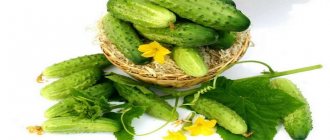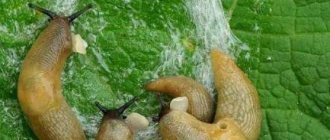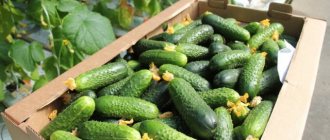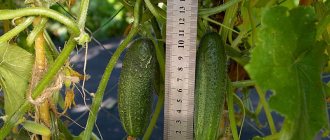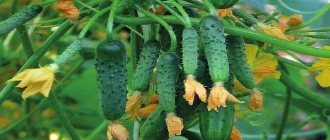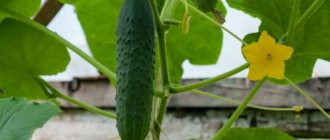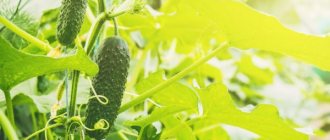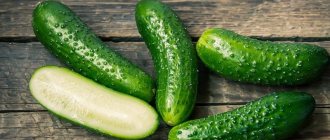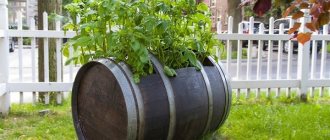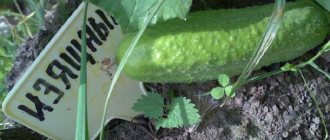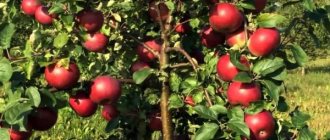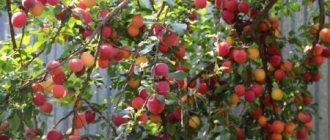Cucumber Gunnar F1 is a universal favorite of farmers. Among the bonuses of the Dutch hybrid, the emphasis is on high productivity, strong immunity, and excellent marketability and taste properties of greens. The fruits of this variety are beneficial for mass sale.
| Landing location | Ripening time | Mode of application | Fruit length | Group | Fruit smoothness | Pollination method |
| Universal | Early ripening (35-45 days) | Universal | Medium - from 10 to 15 cm | Hybrid | Highly lumpy | Parthenocarpic |
Characteristics of the variety
Early ripening and high yields make the Gunnar F1 cucumber attractive for industrial plantings. The first harvest of cucumbers can be harvested within 6-7 weeks after emergence. Bushes with large green leaves form from 2 to 4 ovaries in each axil. Cucumbers of the Gunnar F1 variety are characterized by:
- rich green color;
- small in size - the length of the cucumber is no more than 12-15 cm;
- cylindrical, rounded at the ends, shape;
- lumpy, slightly pubescent skin;
- dense tasty pulp without the slightest bitterness;
- excellent presentation - even overgrown cucumbers of the Gunnar variety do not lose their attractive appearance and taste;
- excellent keeping quality without loss of taste;
- versatility in use;
- excellent transportability;
- the ability to grow cucumbers under film and in open ground;
- high yield when planted in an open area - more than 20 kg per 1 sq. m, and in unheated greenhouses - up to 9 kg per 1 sq. m;
- undemanding to the salt composition of the soil;
- resistance to light frosts;
- resistance to cladosporiosis.
Despite the excellent characteristics of the Gunnar cucumber variety, some of its disadvantages should be noted:
- high cost of seed material;
- insufficient resistance of the Gunnar F1 cucumber to common diseases;
- demanding compliance with agricultural technology.
Productivity
When carrying out high-quality agrotechnical measures, the “Gunnar” variety can achieve the following very high yields, the harvest of which begins: in spring-summer rotation - from 17 to 23 kilograms per 1 m². In the summer-autumn period - from 8 to 13 kilograms per 1 m².
The commercial yield in unheated glass greenhouses is 8.9 kilograms per 1 m². These figures are 2.1 kilograms per 1 m² higher than the standard. Yield of commercial products is 100%.
It follows from this that the variety is quite high-yielding. Fruiting will be abundant both in the early period and throughout the season. This requires a large amount of various fertilizing and fertilizers.
Sowing seeds
Gunnar cucumbers will produce a decent harvest if you follow the growing rules. Before sowing, it is advisable to soak cucumber seeds in phytosporin; many gardeners advise soaking them in aloe or potassium permanganate juice. Such preventive treatment will provide them with high antibacterial resistance.
Important! Seeds of the Gunnar F1 variety should be planted in soil heated to 20-21 degrees and disinfected.
Sowing boxes equipped with good drainage should be filled with loose soil. The looseness of the soil mixture will ensure the addition of humus and peat to the garden soil. A small amount of ash would be a good addition. Gunnar cucumber seeds, as reviews advise, are placed evenly over the surface and sprinkled with a layer of soil up to 1.5-2 cm thick. To speed up the germination of cucumber seeds, you need to cover the boxes with transparent film or glass and place them in a room with a temperature of up to 26-27 degrees.
As soon as the Gunnar F1 cucumber shoots hatch, the temperature is reduced to 19-20 degrees. Watering cucumber sprouts is carried out by spraying. The soil should not be allowed to dry out, but it should not remain too wet.
Cucumber growing technology Gunnar recommends transplanting the seedlings to a permanent place after the appearance of 4 true leaves. If Gunnar cucumbers are grown in film greenhouses, transplantation occurs around mid-May. It is not worth keeping cucumber seedlings too long, as their ability to adapt decreases and a large number of sick and weak plants appear, which will affect the harvest.
Many gardeners prefer to sow cucumber seeds in separate containers, which subsequently makes it easier to transplant seedlings into garden beds.
What are the advantages of Gunnar F1 cucumbers?
Gunnar F1 cucumbers have a lot of advantages, which is why they are considered one of the best for growing for sale and for personal use. Here are the main advantages of Gunar:
- Productivity during spring planting is 18-22 kg/m. sq., and with summer fudge - 9-12 kg/m. sq.
- Once fully ripe, cucumbers do not lose their cylindrical shape, do not become too large or plump, the taste does not deteriorate and they can be stored on the plant for up to several days.
- Due to the fact that the plant is compact, caring for it is simplified.
- Cucumbers last for quite a long time, for at least 1.5-2 weeks nothing happens to them, their appearance, color, or taste do not deteriorate, but only under the right conditions.
- Zelentsy can be transported over considerable distances. Due to the fact that their peel is dense, cucumbers do not spoil on the road and retain their commercial quality for a long time.
- The hybrid has high resistance to brown spot and average resistance to cucumber mosaic virus, powdery mildew, and cucumber yellowing virus.
Cucumber seeds Gunnar F1
Transplanting seedlings into open ground
Cucumber Gunnar F1 loves open sunny places, protected from the wind. Therefore, the planting site should be selected taking into account these characteristics. The best option would be to create beds with Gunnar cucumbers from north to south.
Cucumber roots need to be provided with good aeration, but it should be noted that the main part of the root system is located horizontally, just a few centimeters from the surface. Therefore, ordinary loosening of cucumber bushes leads to damage to the roots, after which the plants take a long time to recover. Sufficient air access can be ensured by mulching and organic fertilizing, as well as the correct predecessors of Gunnar cucumbers. These include different types of cabbage, peas and other green manure.
Sowing preparation and technology
Cucumbers can be planted either by direct sowing of seeds in the ground or by seedlings. Cultivation in greenhouses and open ground is allowed. Seeds are sown both dry and germinated. The choice of methods depends on the personal preferences of the farmer.
Cucumbers are quite light-loving, so regardless of the choice of sowing method, for cultivation you will need a well-lit area, drained fertile soil and regular watering.
Optimal conditions for the growth of the Tumi variety:
- air temperature - +21°...+23°;
- humidity - 60%;
- illumination - an area with bright sun;
- watering - once every 5 days;
- loosening - a day after watering;
- fertilizing is mandatory during the growth, flowering and fruiting phases.
Cucumber is heat-loving. Therefore, depending on the climatic characteristics of the region, the timing of planting seeds will differ. In temperate climate zones, cucumbers are planted in ridges in May - from the beginning to the middle of the month.
You will be interested to know how to properly grow cucumbers on the windowsill and balcony.
In areas with colder climates - from the end of May until the 10th of June. It is not worth planting cucumber seeds at a later date - the crop does not tolerate heat well. And this can affect the formation of fruits.
In the open ground
Start sowing by preparing seeds, soil and containers for seedlings if you want to speed up the time of obtaining the first greenery.
Seed preparation includes:
- Grain calibration. This is soaking the seeds in a warm solution of table salt. The floating seeds are thrown away as they will not sprout. The rest are washed from salt.
- Disinfection in a pale pink solution of potassium permanganate for 30 minutes. In this case, the death of pathogenic bacteria occurs.
- Treatment with “Fitosporin” to strengthen plant immunity. The drug is used according to the instructions.
- Germination within 3–4 days. Place wet gauze in the tray, place the seeds on it and cover them with another layer of gauze. Moisture should not dry out.
If stable warm weather with night temperatures not lower than +15° C has established, the seeds are sown in the ground. If the soil in which the sowing will be carried out is poor in composition, then after digging up the area and removing the weeds, fertilizers are applied. These can be substances of both organic and inorganic origin. The application rate for manure is 5 kg/m².
If possible, ridges are formed from north to south. This provides better lighting to each plant. An excellent option for borage are “warm” ridges 25 cm high. They consist of several layers. One of them is rotted manure with the addition of ash. It creates a kind of thermal cushion. Plants on such a cushion grow faster and bear fruit more actively.
Seed sowing technique:
- Holes are dug in the prepared ridge. The interval between them is 50–60 cm. The seed planting depth should be 1–2 cm.
- Before sowing, add warm water to the hole, and then place 3 seeds in each hole.
- Sprinkle the top of the hole with a 3-centimeter layer of soil.
To smooth out the difference between day and night temperatures, a film cover is made for the cucumbers. The temperature there will be higher, especially at night.
The greenhouse effect enhances the germination and development of cucumber plants. The emerged seedlings are also covered with a film layer. If they are not covered, the leaves quickly become coarser and lose moisture.
In the greenhouse
Growing greenhouse cucumbers is not difficult. Since autumn, the greenhouse has been disinfected and equipment washed. The soil is loosened in the same way as in the beds. And then they apply fertilizer and plant the seeds. Planting is carried out using the trench method. The ditches are made 30 cm deep and filled halfway with manure, and covered with soil on top. Additionally, you can take care of the trellis to which the cucumbers will be tied when the length of the vines exceeds 0.5 m.
Did you know? The ancient Romans were the first to pickle cucumbers. They are the ones
—
authors of the first marinade recipes.
Cucumber care
Cucumber shoots form into one stem, and:
- Shoots and ovaries are removed from the first five axils; in cloudy weather, the ovaries are removed in 8 axils;
- from the fifth to the ninth leaf, one fruit is left in the axil;
- in the following axils, all shoots are removed without touching the ovary;
- behind the fifth leaf, a description of the cucumber variety, Gunnar recommends pinching the growing point;
- yellowed lower leaves are systematically removed - the operation should be carried out in the morning or evening;
- at a height of more than 2 m, a horizontal trellis is strengthened, around which the cucumber stem is wrapped;
- during the first two weeks, greens of the Gunnar F1 cucumber variety are harvested without waiting for them to fully ripen;
- in the future, the crop is harvested every other day;
- When fruiting is active, cucumbers of the Gunnar variety are harvested every day.
Important! If all recommendations for caring for the Gunnar cucumber are followed correctly, then at the same time from three to five fruits ripen on each plant.
Description of the cucumber variety Gunnar F1
Cucumber Gunnar F1 is an early hybrid. The first fruits can be collected 1-1.5 months after emergence. Fruiting is extended, fruits are collected every 2-3 days, and with abundant yields once a day. The plant is compact, does not take up much space, tall, open, parthenocarpic, with female flowering. The root system of the plant is very developed and powerful. The side shoots are short. There are 2-4 fruits in a node.
Photo of Gunnar F1 cucumbers
The fruits are dark green in color, there are no spots or stripes on the peel, it is monochromatic, only closer to the tip the color may lighten. The length of greens is 12-14 cm, their shape is cylindrical. The flesh of the Gunnar F1 cucumber and the peel are dense, so the greens are weighty, 90-100 g each. Bitterness is completely absent, even when overripe. The surface is lumpy, the spines on the fruits are light in color.
Organization of watering
The superficial root system of cucumber requires a constant moisture regime. When there is a lack of moisture, plants become stressed and their foliage becomes dark and brittle. Mulching will help retain moisture in the soil. However, excess moisture is also harmful, it leads to:
- to reduce oxygen content in the soil;
- inhibition of the growth of cucumber shoots and fruit formation;
- change in foliage color.
Characteristics of cucumbers Gunnar warns of the appearance of bitterness in cucumbers during sudden changes in humidity and temperature. The best way to water cucumbers is a drip system. If this is not available, you can settle the water in barrels; its temperature when watering cucumbers should not be lower than +18 degrees, and the best humidity indicator is 80%.
Fertilizers for cucumbers
The Gunnar variety is characterized by active fruiting and requires regular feeding:
- for the first time, plants are fed with ammophoska immediately after transplanting into a greenhouse or open beds;
- after rooting in a new place about two weeks later, a complex fertilizer containing all the necessary minerals is applied to the cucumbers;
- after a week you can feed the cucumber bushes of the Gunnar F1 variety with rotted manure;
- before flowering, plants are watered at the root with mineral fertilizer diluted with water;
- after watering, the cucumber beds are sprinkled with ash;
- After fruit set, nitrogen fertilizing is reduced - at this time, cucumbers require potassium and magnesium to ripen and develop taste.
Many summer residents use folk remedies as fertilizers for cucumbers, which become an excellent alternative to mineral supplements - bread yeast, onion peels, stale bread.
Root feeding for Gunnar cucumbers should be applied after watering or rain, preferably in the evening or in cloudy weather. They are more effective in warm seasons. If the summer is cool, it is easier for plants to absorb foliar fertilizers. The procedure for spraying Gunnar cucumbers, as can be seen from the description and photo, is carried out in the evening, the solution is sprayed in small drops and as evenly as possible.
Diseases and pests
If you follow the rules of agricultural technology in greenhouses, cucumbers of the Gunnar variety are not afraid of diseases and pests, but in open ground plants can be damaged by fungal diseases:
- powdery mildew, which can reduce the yield of Gunnar cucumbers by almost half;
- downy mildew, which can practically destroy all plantings.
The best way to combat diseases of cucumbers of the Gunnar F1 variety is to maintain optimal temperature and humidity, as well as preventive treatments with special preparations.
Among the pests, melon aphids or spider mites may appear on cucumber bushes, against which treatments with solutions of tobacco, garlic and other drugs are effective.
How to grow your own
The seeds of the Gunnar hybrid are not treated before sowing - the manufacturer has already taken care of this.
Planting seeds and seedlings
Plant the seeds to a depth of 1-2 cm at a temperature of the top layer of soil not lower than +17 °C.
Soil requirements:
- increased breathability;
- neutral pH;
- high humidity;
- high percentage of soil bacteria.
Complex fertilizers are applied to the garden bed, the furrows are well watered, then the seeds are planted and sprinkled with soil.
To grow seedlings, the prepared soil mixture is poured into special cassettes or other suitable container. Place a seed in the center and sprinkle 1 cm of soil.
The container is placed in a warm, well-lit place. After emergence of seedlings, the temperature is reduced to +20 °C. The seedlings are watered with warm water. When 3 leaves appear, they are planted in a permanent place. Complete planting with mulching.
Brooder for broilers - keeping chickens, what temperature should be
Step-by-step cultivation and care
Gunnar cucumbers need constant watering with warm water. It is important to ensure that drops do not fall on the leaves and stems. Often gardeners install a convenient drip irrigation system.
From the moment the plants develop, moderate watering is carried out, and from the beginning of fruiting its volume is increased. Each bush is provided with 1-2 liters of water, in the future - 4 liters.
For good yield indicators, plants are fed with complex mineral fertilizers. Contents of 1-2 liters are added per 1 m2.
After moisture or rain, loosen the soil and remove weeds.
Features of cultivation and possible difficulties
When drip irrigation is used, the tape is placed not under the mulch, but on top of it. For active formation of ovaries from planting to flowering, moderate irrigation is carried out, then it is increased, since Gunnar is demanding of moisture. This feature requires the consumption of large volumes of water.
Important! Monitor the volume of water without leaving the soil too wet or dry.
With each subsequent feeding, the fertilizer should contain less nitrogen and a little more potassium and phosphorus.
Unlike non-hybrid cucumbers, Gunnar is formed into a single stem. For the correct development of the bushes, a “blinding” procedure is carried out: all shoots and ovaries that formed at a height of 5–8 internodes from the ground are removed. The ovaries that form higher are left, and if shoots appear, they are also removed. Pinch the bush at a height of 3 or 5 leaves from the growing point.
For gartering, it is more convenient to use a mesh, guiding the stem and twisting it around the cells. When growing Gunnar in open ground, the height of such a device is about 2 m, and for greenhouse cucumbers its size is determined by the height of the room.
The lower dried leaves are removed in the morning or evening. At this time, the plants will not experience severe stress.
Diseases and pests
Gunnar is resistant to the most common plant diseases. If all care measures are followed, the risks of plant damage are low.
To prevent fungal diseases, bushes are sprayed with sodium polysulfide. To prevent infection by downy mildew, the beds are treated with fungicides.
When growing Gunnar in greenhouse conditions, he is not threatened by insects. In open ground, the crop is attacked by sprout flies, spider mites and melon aphids. To get rid of them, plants are treated with karbofos or tobacco solution.
Reviews from vegetable growers
The cucumber variety Gunnar F1 is highly valued not only by summer residents, but also by farmers who grow it in greenhouses on an industrial scale.
Anna Peresporova, 45 years old, Voronezh
The cucumber variety Gunnar F1 differs from other hybrids in having more powerful and thick stems. Even in low light it gives excellent results. Responds well to feeding. If you follow very simple rules of agricultural technology, then you don’t need a better variety.
Kolpakov Gennady, 68 years old, Nizhny Novgorod
For the third year now I have been growing cucumbers of the Gunnar F1 variety on my plot and I do not regret my choice. High yield is combined with excellent taste and ease of care. Cucumber Gunnar loves feeding, as it consumes a large amount of nutrients during active fruiting. I feed it with rotted manure, bird droppings, and use mineral supplements. Excellent variety.
Popova Galina, 52 years old, Klin
I am engaged in the industrial cultivation of cucumbers. Last year I decided to try a new Dutch cucumber variety, Gunnar F1. He pleased with high yields and excellent presentation. It transports well, and most importantly – excellent taste, which consumers especially pay attention to. A good variety for greenhouse production.
Karamelkov Boris, 64 years old, Krasnodar
I have been planting Gunnar cucumbers in my garden for two years now. I plant the seeds directly into the ground when constant heat sets in. They quickly produce friendly shoots and do not require pollination by bees. Maintenance is simple - water, feed and tie up on time, as the bushes are very tall. The harvest is good. Cucumbers are delicious both fresh and pickled.
Growing
Planting seedlings
Like any other cucumber, Gunnar can be grown either by seedlings or by direct sowing in the ground. It all depends on how important getting an early harvest is to you. The seedling method makes it possible to gain time, since seedlings can be planted early and kept warm at home, while the soil will only warm up to the desired temperature (above plus 15 degrees). Seeds for seedlings can be sown about a month before the intended planting in the ground. That is, if planting is expected in early June, then we sow seedlings in early May. In this case, the harvest can begin to be harvested in mid-June. After planting in the ground, the plants rapidly grow and quickly begin to bear fruit.
Direct sowing has its advantages over the seedling method. The plants immediately go to their permanent location. The composition of the soil and temperature conditions do not change, as happens when planting seedlings. Consequently, plants do not experience stress and develop harmoniously. At first, the cucumber will grow roots, so the growing season will be slower compared to how it happens in a seedling pot. But after the root system has developed an area sufficient to provide the plant with nutrition, the vine begins to rapidly vegetate and set fruit.
Top dressing
This variety of cucumbers produces a good harvest, but when feeding, the productivity of the plant increases significantly. Cucumber responds well to leaf feeding with a weak solution of organic fertilizer with a predominant potassium content. It will be good if the fertilizing also contains microelements. It’s a good idea to carry out such feeding once every 10-14 days.
Diseases and their prevention
The plant is resistant to many of the serious diseases mentioned above. But in order to prevent other diseases, as well as protect against insects, periodic treatments with biological products can be carried out.
Productivity/Harvest/Storage Rules
Subject to the necessary growing and care conditions, you can collect more than twenty kilograms per 1 square meter. meter. The fruits of the Gunnar cucumber are easily transported and can be stored for a long time in a cool, dark place without losing their presentation or taste.
Fruits and taste
The fruits are smooth, about 13 centimeters in length, with an average weight of about 100 grams. Dark thin skin with spines without stripes. The pulp is crispy, aromatic and slightly sweet in taste. Suitable for preservation and fresh consumption.
Reviews
Yulia: “Cucumbers have excellent taste and are suitable for growing in a greenhouse. They hardly get sick, but the seeds are expensive.”
Pavel: “I collect more than twenty kilograms per square, everything is great! Cucumbers do not get sick, but they are very demanding to care for; you need to carefully prepare the seedlings.”
